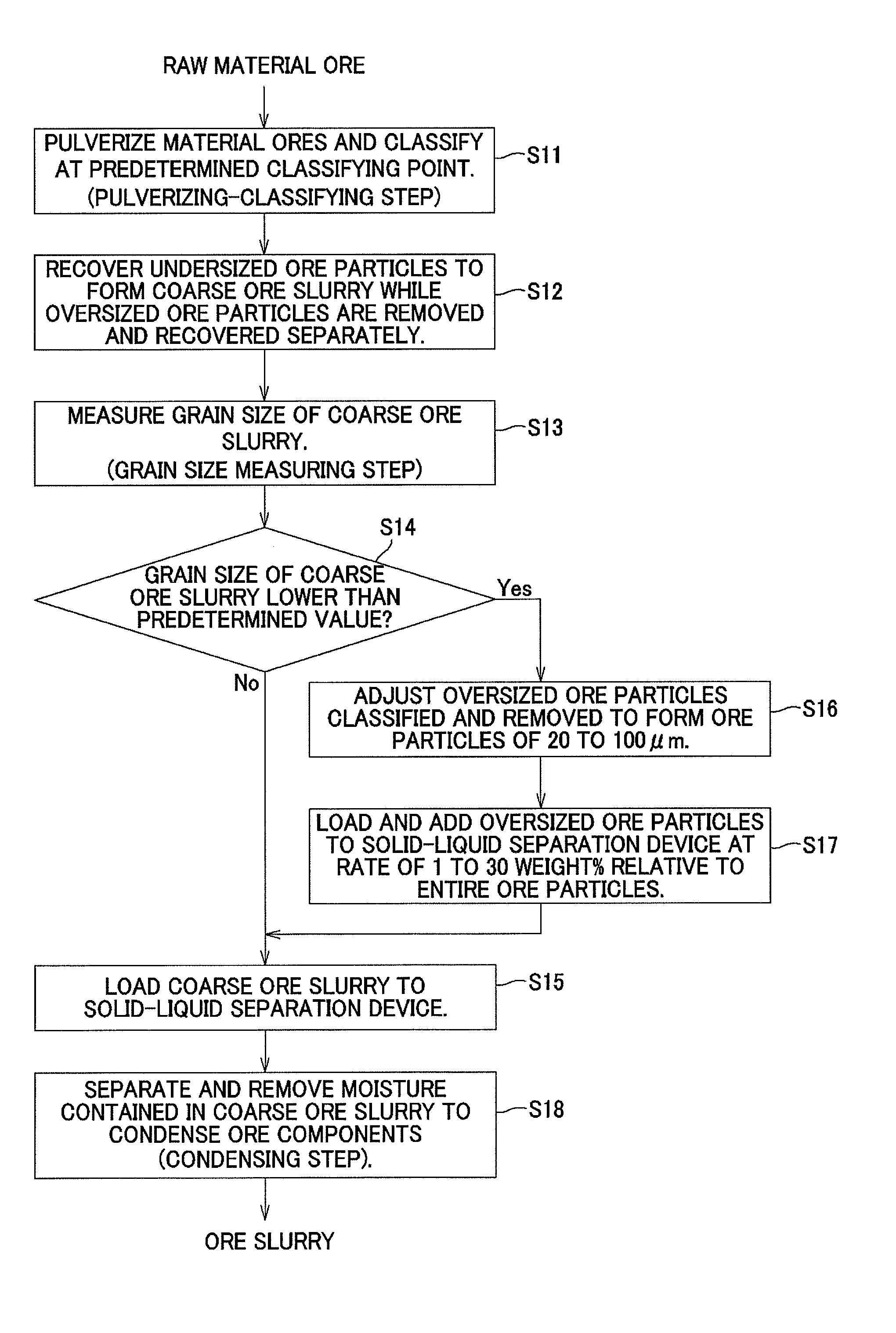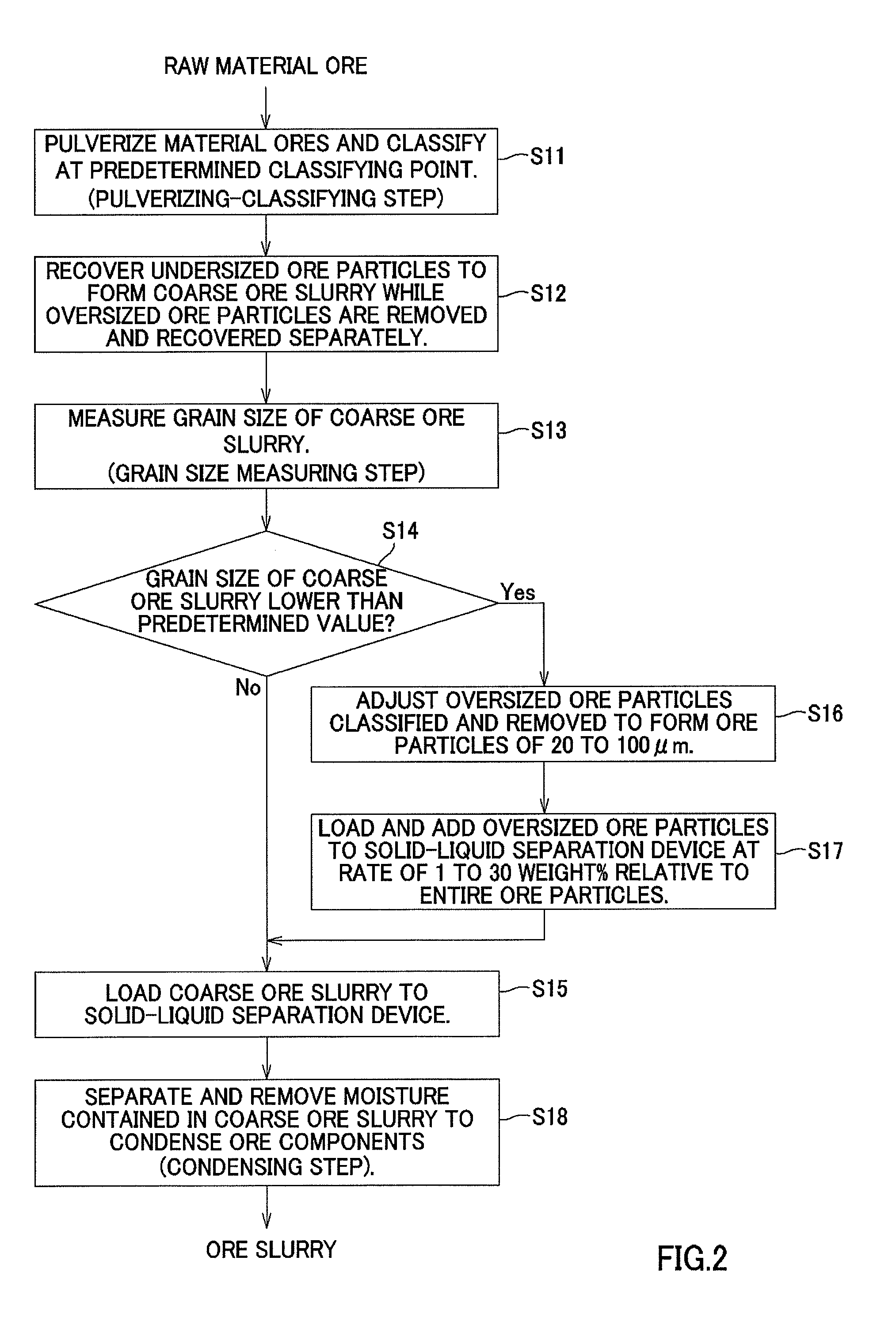Ore slurry production method and metal refining method
a technology of ore slurry and metal refining, which is applied in the direction of grain treatment, etc., can solve the problems of inability to carry out the transport process using a general-use slurry transporting pump, the viscosity of the resulting ore slurry is too high, and the ore slurry is too large to achieve the effect of reducing the viscosity of the ore slurry, facilitating the operation, and facilitating the operation
- Summary
- Abstract
- Description
- Claims
- Application Information
AI Technical Summary
Benefits of technology
Problems solved by technology
Method used
Image
Examples
example 1
[0121]In an ore slurry producing step for use in recovering nickel and cobalt from nickel oxide ores serving as raw material ores, by a high-temperature pressure acid leaching method (HPAL method) by the use of sulfuric acid, first, nickel oxide ores were pulverized by using a general-use pulverizer. Then, the pulverized nickel oxide ores were classified by using a sieve with a mesh having an opening of 1.4 mm. The undersized ore particles classified by the classifying process were recovered so that a coarse ore slurry containing 100 g / L of solid components was produced. On the other hand, the classified oversized ore particles were removed and recovered in a separated manner.
[0122]Next, the grain size of the coarse ore slurry was measured by using a Microtrack Device (9320-X100, made by Nikkiso Co., Ltd.). In this case, the grain size of the coarse ore slurry was measured to obtain a volume-average diameter (mv) as a measured value. As a result, the particle diameter of the coarse ...
example 2
[0127]By carrying out a pulverizing / classifying process on nickel oxide ores serving as raw material ores in the same manner as in example 1, a coarse ore slurry was obtained, and the same processes as those of example 1 were carried out so that a similar ore slurry was obtained except that when the grain size of the resulting coarse ore slurry was measured, the particle diameter of the coarse ore slurry was 14.26 μm.
[0128]The yield stress of the resulting ore slurry was measured by using a rheometer in the same manner as in example 1. As a result, the yield stress of the ore slurry was 160 Pa so that it was possible to transport the slurry to the next leaching step by using a general-use transporting pump, without causing any transporting failure, etc.
[0129]Moreover, in the succeeding leaching step by the use of the HPAL method also, the nickel leaching rate was 93.2%, which was a satisfactory result.
example 3
[0130]By carrying out the pulverizing / classifying process on nickel oxide ores serving as raw material ores in the same manner as in example 1, a coarse ore slurry was obtained, and the same processes as those of example 1 were carried out so that a similar ore slurry was obtained except that when the grain size of the resulting coarse ore slurry was measured, the particle diameter of the coarse ore slurry was 18.26 μm.
[0131]The yield stress of the resulting ore slurry was measured by using a rheometer in the same manner as in example 1. As a result, the yield stress of the ore slurry was 150 Pa so that it was possible to transport the slurry to the next leaching step by using a general-use transporting pump, without causing any transporting failure, etc.
[0132]Moreover, in the succeeding leaching step by the use of the HPAL method also, the nickel leaching rate was 93.0%, which was a satisfactory result.
PUM
| Property | Measurement | Unit |
|---|---|---|
| yield stress | aaaaa | aaaaa |
| grain size | aaaaa | aaaaa |
| particle size | aaaaa | aaaaa |
Abstract
Description
Claims
Application Information
 Login to View More
Login to View More - R&D
- Intellectual Property
- Life Sciences
- Materials
- Tech Scout
- Unparalleled Data Quality
- Higher Quality Content
- 60% Fewer Hallucinations
Browse by: Latest US Patents, China's latest patents, Technical Efficacy Thesaurus, Application Domain, Technology Topic, Popular Technical Reports.
© 2025 PatSnap. All rights reserved.Legal|Privacy policy|Modern Slavery Act Transparency Statement|Sitemap|About US| Contact US: help@patsnap.com



